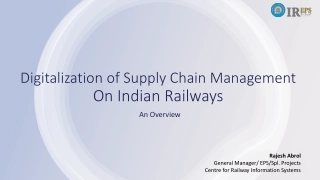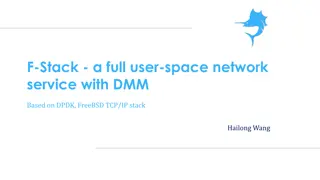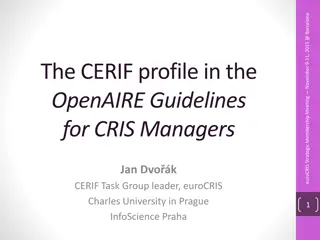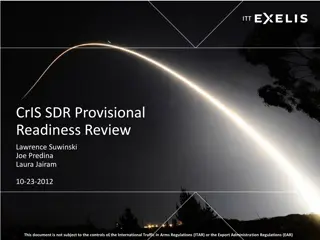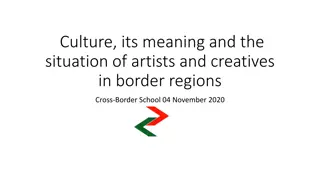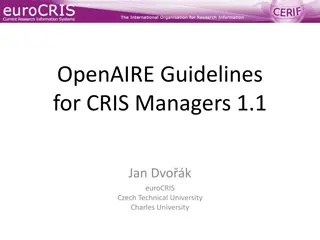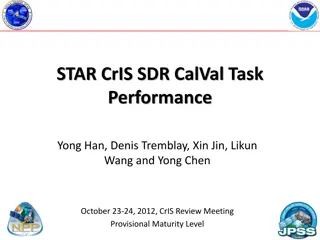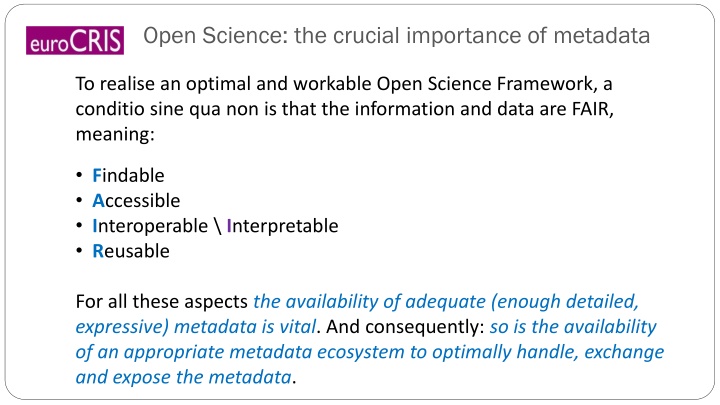
Importance of Metadata in Open Science Framework
Discover the crucial role of metadata in establishing an effective Open Science Framework. Learn how a robust metadata ecosystem enhances the Findable, Accessible, Interoperable, and Reusable (FAIR) nature of data. Explore the significance of Research Information Systems (CRIS) as treasure troves of interconnected metadata for various research aspects, from researchers to projects, organizations, outputs, and impacts. Delve into the evolution of CRIS from administrative tools to vital resources for research information. Join the discussion on integrating CRIS information into FAIR data infrastructure for optimal outcomes in Open Science.
Download Presentation

Please find below an Image/Link to download the presentation.
The content on the website is provided AS IS for your information and personal use only. It may not be sold, licensed, or shared on other websites without obtaining consent from the author. If you encounter any issues during the download, it is possible that the publisher has removed the file from their server.
You are allowed to download the files provided on this website for personal or commercial use, subject to the condition that they are used lawfully. All files are the property of their respective owners.
The content on the website is provided AS IS for your information and personal use only. It may not be sold, licensed, or shared on other websites without obtaining consent from the author.
E N D
Presentation Transcript
Open Science: the crucial importance of metadata To realise an optimal and workable Open Science Framework, a conditio sine qua non is that the information and data are FAIR, meaning: Findable Accessible Interoperable \ Interpretable Reusable For all these aspects the availability of adequate (enough detailed, expressive) metadata is vital. And consequently: so is the availability of an appropriate metadata ecosystem to optimally handle, exchange and expose the metadata.
CRIS: Treasure Chests of metadata A CRIS is an information system that holds (interlinked) metadata about virtually all aspects of research: The researchers(ID, name, title, affiliation, ...) and their role in the research. The projects (ID, title, description, key words, start- and enddate, ...) The organisations(institutes, universities, ) involved and their role (owner, funder, ...) The inputinvested in the research both in time (f.t.e.) and money. The outputfrom the research (publications, datasets, software, patents, images, etc...) The equipment, services and tools (e.g. which version of whic software)used. Thefield or subject of the research. The impact of the research, both in- and outside of academia (metrics, impact indicators, ). Semanticclassifications of the research on various dimensions (typologies, ...), Rights metadata: who is authorised or which conditions may apply to access (some of the) information in the CRIS Cooperationswith other projects, researchers, groups, organisations. Links to other systems (HRM, financial, external: ORCID, WoS, Scopus, ...) Etc
CRIS, a big switch in time. In the course of time CRIS have made a big switch: from tools for research administration to primary resources of research information. In terms of stakeholders/target groups: from administrators to the research(ers) community. Initially, CRIS: resources for administrative purposes, notably management, monitoring, evaluation and benchmarking of research. Awareness has grown about the big potential of CRIS for profiling and showcasing research. In general: for making research known to the world The information in CRIS constitute what may be called, an interconnected and multiple chain of variables (entries) for searching, finding and interpreting research data, their accessibility and their reusability. Therefore: it makes a world of difference to a user searching for relevant research data when the metadata that directly apply to the datasets are enriched by the additional metadata available in CRIS. about aspects and entities linked to the dataset.
Resulting Propostions for discussion In order to realize an optimal FAIR and Open data and Science infrastructure the integration of (the information available in) CRIS (infrastructure) is recommendable if not necessary. Resulting from this: The Open Science an FAIR Data communities on the one hand and the CRIS Community on the other should come together and jointly cooperate to work this out.
A European Research Information Infrastructure is possible in the near future. Conclusion of a report of a working group of the European Parliament (April 2014): We conclude that a European Integrated Research Information Infrastructure is technically feasible thanks to recent technological developments and especially the maturity of the European CERIF standard, which allows seamless interlinking of datasets and/or research information systems, in different formats and including non-CERIF systems
A European Research Information Infrastructure is possible in the near future. Conclusion of a report of a working group of the European Parliament (April 2014): STOA-Report: Measuring Scientific Performance for Improved Policy Making, p. 14.
European Research Information Infrastructure: an Architecture. Standard use case / profile Standard use case / profile Standard use case / profile Standard use case / profile Standard use case / profile Standard use case / profile NATIONAL and LOCAL CRIS AND REPOSITORIES
CRISs new field of application: Research DATA DATA sets selection final dataset articles data life cycle management analysis temporary temporary storage storage CRIS: linking publications to dataset + archiving of data. publication of results data collection CRIS: registration of (metadata) for dataset

